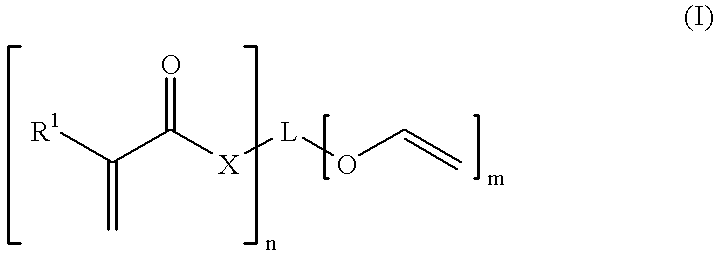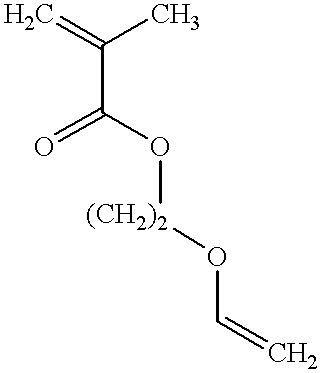Ink compositions for ink jet printing
- Summary
- Abstract
- Description
- Claims
- Application Information
AI Technical Summary
Benefits of technology
Problems solved by technology
Method used
Image
Examples
example 1
Free radical polymerization of non-colored inks
The general composition of the non-colored radiation curable inks of the invention is:
Ultra-violet polymerizing oligomer CN 501 (amine modified polyether acrylate, Cray Valley);
Monomer of the invention (see table 2); the numbering of the monomers corresponds to table 1 in the Detailed Description section, see above;
2-isopropylthioxanthone (Quantacure ITX, Rahn AG) as photoinitiator;
N-methyl diethanolamine (NMDA) as co-initiator or synergist; ethanol.
Substituting the monomer of the invention by the difunctional monomer dipropylene glycol diacrylate (Radcure DPGDA, UCB) as comparative diluent gave rise to a comparative ink composition.
All inks were prepared on a basis of a total final weight of 20 g. All ink compositions are indicated in table 2 in weight percentage:
all inks contained 2% wt of NMDA, 2% wt of ethanol and 10% wt of Quantacure ITX. Firstly, the Radcure DPGDA or monomer of the invention was added to the CN501. The resulting m...
example 2
Free Radical Polymerization of Black Inks
The general composition of the black colored radiation curable inks of the invention was:
Ultraviolet polymerizing oligomer CN 501 (amine modified polyether acrylate, Cray Valley)
Monomer of the invention (see table 4)
N-methyl diethanol amine (NMDA as co-initiator or synergist Ethanol
2-isopropylthixanthone (Quantacure ITX, Rahn AG)
Special black 250 (Degussa)
Solpserse 24000SC (Zeneca)
Substituting the monomer of the invention by the difunctional monomer dipropylene glycol diacrylate (Radcure DPGDA , UCB) as comparative diluent gave rise to a comparative ink composition. All inks were prepared on a basis of a total final weight of 20 g. All ink compositions are indicated in table 3 in weight percentage: they all contained 2% wt of NMDA, 2% wt of ethanol and 10% wt of Quantacure ITX.
Firstly, the Radcure DPGDA or monomer of the invention was added to the CN501. The resulting mixture was stirred for a couple of minutes until the added diluent was com...
example 3
Cationic Polymerization of Non-Colored Inks
The general composition of the non-colored radiation curable inks of the invention was:
Ultra-violet: polymerizing base epoxidle resin UTVR6105 (3,4 epoxycyclohexylmethyl 3, 4 epoxycyclohexane carboxylate; Union Carbide Corporation);
Monomer of the invention (see table 6);
ethanol;
UV 9380 C : according to the MSDS of GE Silicones: a mixture of 1-5 wt % of 2-isopropylthioxanthone, 30-60 wt % C12 &C14 alkylglycidylethers, 30-60 wt % bis (4-dodecylphenyl) iodoniumhexafluoroantimonate, 5-10 wt % linear alkylate dodecylbenzene.
Substituting the monomer of the invention by the monofunctional epoxide UV 6216 (1,2 epoxyhexadecane) as comparative diluent gave rise to a comparative ink composition.
All inks were prepared on a basis of a total final weight of 20 g. All ink compositions are indicated in table 6 in weight percentage: they all had 2% wt of ethanol and 10% wt of UV 9380C. Firstly, the UVR6216 or monomer of the invention was added to the W VR61...
PUM
| Property | Measurement | Unit |
|---|---|---|
| Angle | aaaaa | aaaaa |
| Viscosity | aaaaa | aaaaa |
| Viscosity | aaaaa | aaaaa |
Abstract
Description
Claims
Application Information
 Login to View More
Login to View More - R&D
- Intellectual Property
- Life Sciences
- Materials
- Tech Scout
- Unparalleled Data Quality
- Higher Quality Content
- 60% Fewer Hallucinations
Browse by: Latest US Patents, China's latest patents, Technical Efficacy Thesaurus, Application Domain, Technology Topic, Popular Technical Reports.
© 2025 PatSnap. All rights reserved.Legal|Privacy policy|Modern Slavery Act Transparency Statement|Sitemap|About US| Contact US: help@patsnap.com



